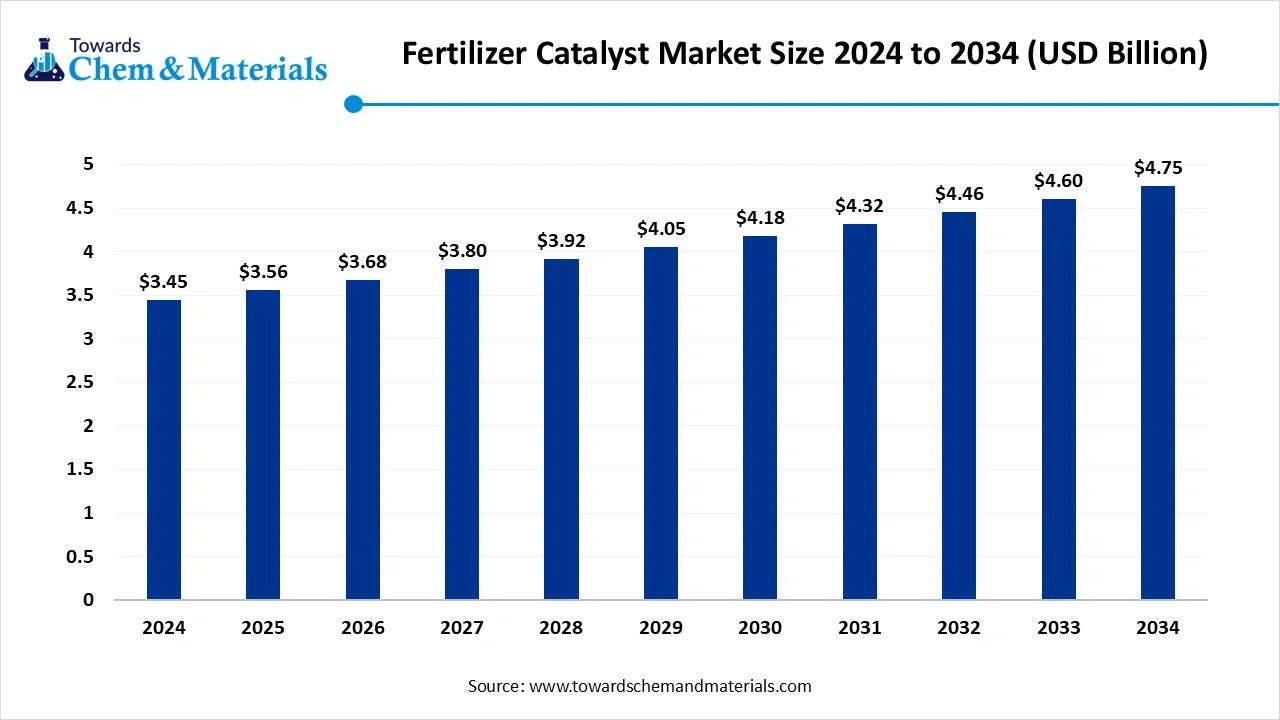November 2025
The fertilizer catalysts market size is calculated at USD 3.45 billion in 2024, grew to USD 3.56 billion in 2025, and is projected to reach around USD 4.75 billion by 2034. The market is expanding at a CAGR of 3.25% between 2025 and 2034. Increasing demand for food security is the key factor driving market growth. Also, technological innovations such as nano catalysts coupled with the stringent environmental regulations focusing on cleaner production can fuel market growth further.

The market is fuelled by the growing need for higher crop yields and increasing global food demand. It is the market for specialized substances that boosts chemical reactions in the manufacturing of fertilizers. These catalysts, like platinum, iron, and rhodium compounds, are essential for enhancing the efficiency, yield, and sustainability of production processes such as ammonia synthesis, nitric acid production, and urea formation.
| Report Attributes | Details |
| Market Size in 2025 | USD 3.56 Billion |
| Expected Size by 2034 | USD 4.75 Billion |
| Growth Rate from 2025 to 2034 | CAGR 3.25% |
| Base Year of Estimation | 2024 |
| Forecast Period | 2025 - 2034 |
| Dominant Region | Asia Pacific |
| Segment Covered | By Process, By Product, By Region |
| Key Companies Profiled | Albemarle Corporation, LKAB Minerals AB, Quality Magnetite, OhamIndustries, Axens, Agricen,Thyssenkrupp AG |
Key technological shifts in the market are mainly fuelled by demand for energy efficiency, sustainability, and operational enhancements in fertilizer manufacturing. The market is moving more towards sustainable and potentially decentralized manufacturing methods.
| Country/Region | Key Regulations |
| United States (USA) | The EPA's regulations under 40 CFR section 261.4(a)(21) provide conditions for recycling hazardous secondary materials to make zinc fertilizers, including strict contaminant limits for heavy metals. |
| India | The government introduced the Fertilizer (Control) Fourth Amendment Order, 2025, which sets new standards for biostimulants, microbial formulations, and other innovative fertilizers to support sustainable farming practices |
| China | It is illegal to produce, import, or sell unregistered fertilizers in China. The Ministry of Agriculture and Rural Affairs (MARA) oversees a registration system with different categories based on the fertilizer type.. |
A major growth opportunity for the market lies in the development of sustainable technologies. With rising global emphasis on sustainability to minimize emissions of greenhouse gases, fertilizer manufacturers are increasingly adopting cleaner manufacturing techniques. Furthermore, cutting-edge catalysis designed to function at much lower temperatures and pressures can substantially cut overall carbon output.
The strong availability of conventional and less-expensive fertilizers, particularly in emerging regions, is the major factor hindering the market growth. These traditional alternatives can limit the adoption of more costly and state-of-the-art catalyst technologies. Moreover, some chemicals utilized in fertilizer manufacturing and other processes can pose certain health risks.
Which Process Type Segment Dominated the Fertilizer Catalysts Market in 2024?
The Haber-Bosch process segment dominated the market with the largest share in 2024. The dominance of the segment can be attributed to the increasing demand for efficient nitrogen-based fertilizers along with the ongoing development of more sustainable and cost-effective catalyst technologies. Additionally, the use of high-performance and low-cost catalysts such as iron is a major factor contributing to the segment's dominance.
The urea production process segment is expected to grow at the fastest CAGR over the forecast period. The growth of the segment can be credited to the rise in adoption of sustainable farming practices, coupled with the government support for fertilizers. Advancements in catalyst technology aim to minimize greenhouse gas emissions from ammonia plants, which is a crucial step in the production of urea.
How Much Share Did the Iron-Based Catalysts Segment Held in 2024?
The iron-based catalysts segment held the largest market share in 2024. The dominance of the segment can be linked to its cost-effectiveness and environmental benefits, such as lower emissions. Moreover, iron catalysts can bear the high temperatures and pressures most common in fertilizer production, which results in a long operational life and lower maintenance needs.
The nickel-based catalysts segment is expected to grow at the fastest CAGR during the projected period. The growth of the segment can be driven by increasing emphasis on cleaner manufacturing practices, along with the rapid advancements in catalyst formulation and design, which lead to more durable and effective catalysts. Furthermore, nickel-based catalysts are more efficient in hydrogenation processes.
Asia Pacific dominated the market by holding the largest market share in 2024.
The dominance of the region can be attributed to the rapid urbanisation and economic development in the region, coupled with the advent of new government initiatives to fuel agricultural productivity. In addition, governments of developing countries are implement ting policies and offering financial support to incentivize the use of catalysts.
China Fertilizer Catalysts Market Trends
In the Asia Pacific, China led the market due to the ongoing inclination towards more efficient and sustainable technologies, along with the stringent government regulations. Also, China is the major consumer of fertilizers globally due to its large population and agricultural sector.
North America is expected to grow at the fastest CAGR over the forecast period.
The growth of the region can be credited to the stringent environmental regulations and a surge in agricultural efficiency. Furthermore, the region boasts a robust R&D infrastructure often fuelled by partnerships between universities and industry, which can impact positive regional growth soon.
U.S. Fertilizer Catalysts Market Trends
In North America, the U.S. dominated the market by holding the largest market share due to innovations in catalyst technology and stringent environmental regulations. The move towards "green ammonia" production creates new market avenues for catalysts compatible with these processes.
By Process
By Product
By Region
November 2025
November 2025
November 2025
November 2025